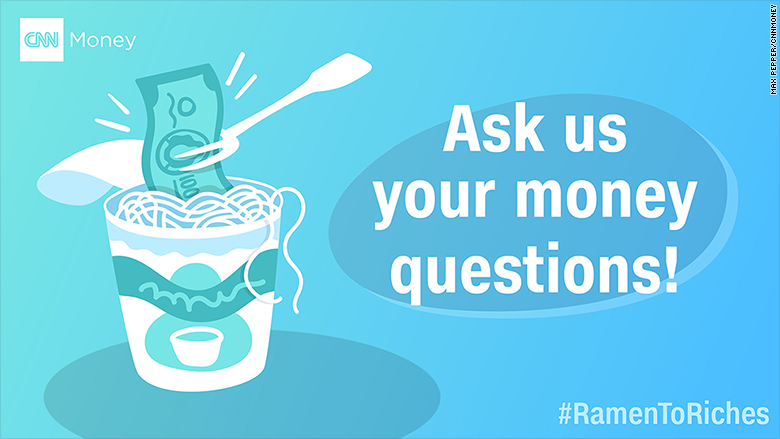What should a person do if she has the same amount of credit card debt as she does savings in the bank (which includes her emergency fund)? Say $10,000 each? Since the debt is unsecured, is it best to just pay the credit cards down or keep the emergency fund instead? -- Jen
Jen is in good company. Even the most responsible spenders can rely on credit cards from time to time. Sometimes the splurge is intentional, other times consumers don't realize they're overspending.
But if you're not careful, you could end up with credit card debt. Here's what you need to do to solve the problem:
Step 1: Stop using the credit card
If you do find yourself with debt, financial planners say to take control of the situation immediately. The first step is to stop using the cards.

"You can get out of the hole, but you have to stop digging," explains David Mullins, a CFP at Virginia-based firm David Mullins Wealth Management.
Step 2: Review your spending habits
The best way to get on top of credit card debt is to create a budget, says Thomas Balcom, a CFP for Miami-based firm 1650 Wealth Management. Doing so can help you identify why you're in debt in the first place.
"It doesn't matter whether you're making $50,000 or $1 million a year, if you're not budgeting correctly you're going to have issues," says Balcom. He recommends reviewing monthly spending patterns and cutting back where possible. Mullins agrees, adding that cash -- not credit -- should become "your new best friend."
If you don't know how to create a budget, you might want to meet with a certified financial planner. These experts can help you get your spending on track. You could also reach out to a non-profit credit counseling service, like the NFCC, suggests Leslie Beck, a New Jersey-based CFP for Compass Wealth Management. These non-profits can help manage your credit and make payments.
Step 3: Find the right repayment plan
Once you've evaluated your spending habits, it's time to figure out the best way to pay off your debt.
Jen wonders if she should use her $10,000 emergency savings fund to pay off her $10,000 credit card debt. While it would be helpful to put some of the savings toward her debt, experts recommend that consumers maintain at least some savings in case of emergencies.
"If she's got stable employment, I would recommend she take half that money and pay down the credit card debt to lower the monthly minimum payment," says Beck.
Mullins believes that with just $10,000, she shouldn't user her savings at all. "That's her lifeline," he explains.
Related: 5 things Millennials need to know about retirement
One way to lower monthly payments without using savings is to contact your credit card company, Beck recommends. Often they'll work with you to reduce your interest rate and make your payments manageable.
If you have multiple credit cards with different interest rates, Onisa Treibs, VP Branch Manager at Fidelity, says you have several options:
1. Ride the debt avalanche. With this approach, you address the credit card with the highest interest rate first. This is a good option if you're up for a challenge, but others might find it overwhelming to pay down big balances.
2. Throw the debt snowball. In this case you pay off cards with the lowest balance first. This approach can help if you're need some "emotional wins," explains Treibs.
3. Conquer the debt blizzard. The debt blizzard is a combination of the debt avalanche and debt snowball approaches. Consumers start by paying off low-balance cards and then switch to addressing the more burdensome cards. This could be the right approach if you're using the debt snowball and suddenly come into more money.
Ramen to Riches: Should real estate be part of my retirement plan?
Another option is to combine your balances onto one card. Often when you consolidate, credit card companies will give you a 0% rate for a limited time. But consumer beware: This is a strictly short-term solution and could lead to more debt if you're not careful and don't pay the card off before the 0% period ends.
"You've got to really read the fine print. If it looks too good to be true, it is," says Beck.
Consumers could also consider refinancing for a lower interest rate. Beck and Mullins recommend using online lenders like SoFi, but caution that refinancing isn't for everyone -- especially if you're tight on cash. Traditional loans often demand low minimum payments, while refinanced loans will likely cost more per month.
"If you can guarantee your spending habits have changed and you've cut up your credit cards, yes, [refinancing] absolutely makes sense," explains Mullins.
Step 4: Make your payments on time
So, you've created a budget and found the best repayment plan. The next step? Make your payments on time.
"If you have any type of late payment on your credit card bills, that can go against your credit score," explains Treibs. If bills tend to creep up, you could set up an automatic recurring payment plan.
No matter what, don't give up.
"You're going to go through your life in waves of credit card debt and no debt," Treibs says. "Don't beat yourself up over it."
Send us your money questions for a chance to be featured in Ramen to Riches! Ask us here or email FromRamentoRiches@cnn.com.

